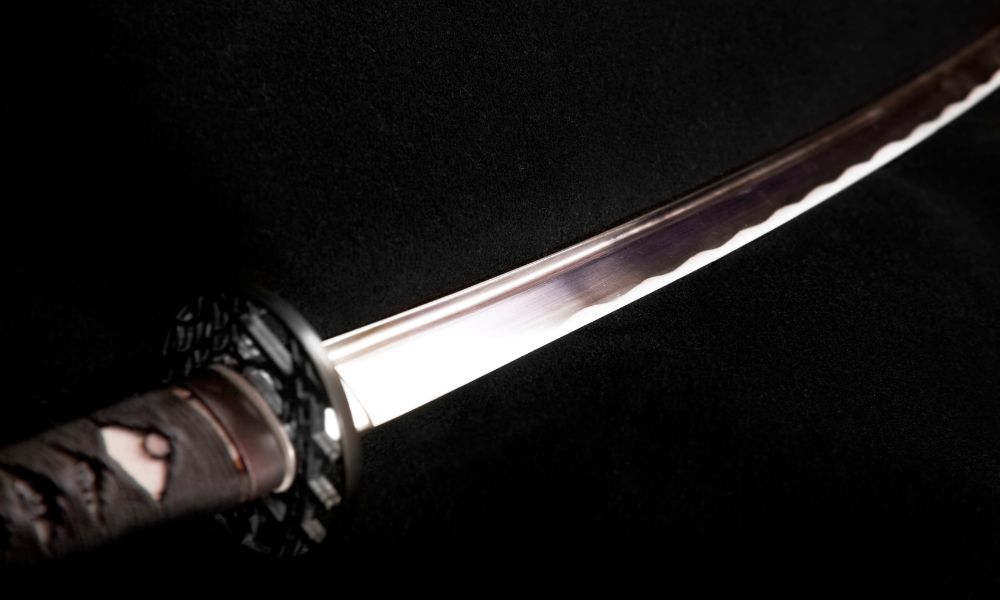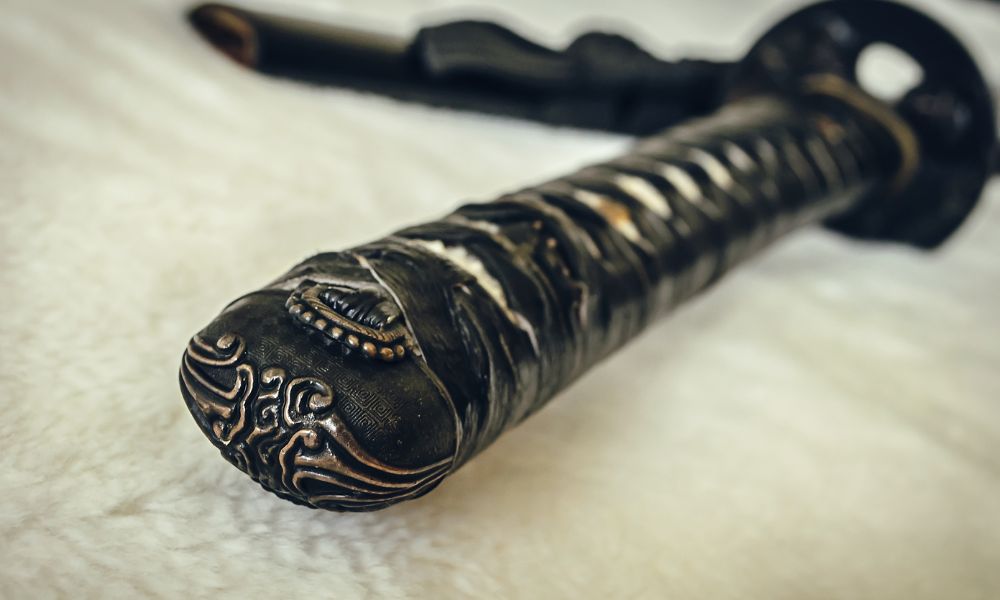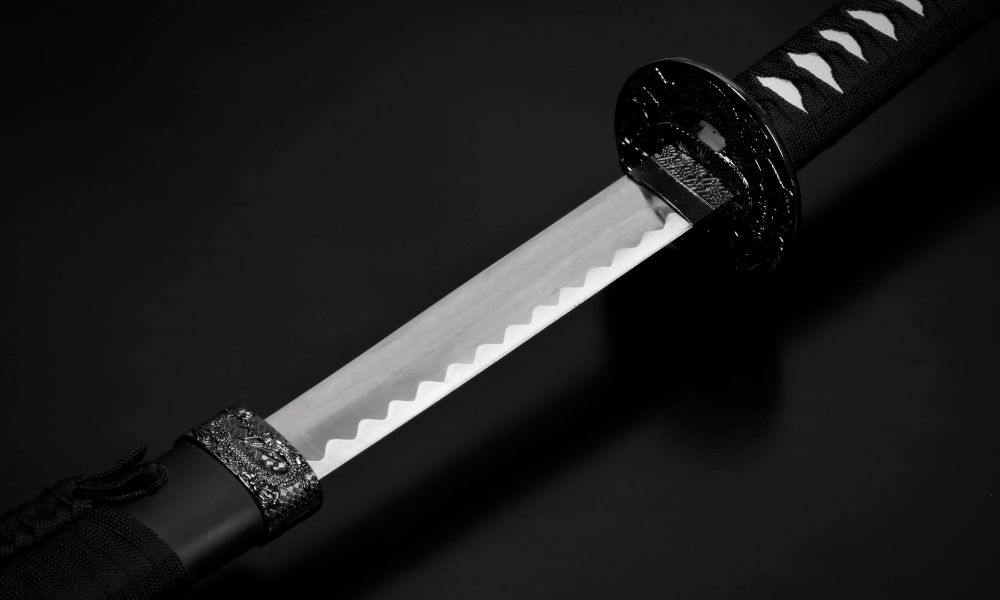A single-edged Japanese sword appeared first in the Kamakura period, now become quite popular outside the country. We call it katana, but there are many names behind one. It’s a collective word for Japanese swords of each length and type of use.
Katana had become one of the most world-famous types of swords. You may see Japanese katana in films, games, or even special cartoons. But how could we learn about it without knowing how exactly its parts are described? Let’s check it out.

Contents
- 1 Key values of samurai sword
- 2 Kireaji ga ii, or how sharp is your katana blade?
- 3 The main part of a weapon
- 4 What is the blood groove on a katana called?
- 5 Why do we need a hi
- 6 Types
- 7 An original method to prove its quality
- 8 Sword blade secrets
- 9 Similar to western blades
- 10 Patterning and carving
- 11 Protective parts
- 12 What is the katana handle called?
- 13 Shapes variety of nakago:
- 14 Differences between real and false sword
- 15 How do we call a katana handle
- 16 What covers a tsuka
- 17 Wrapping of a handle
- 18 Decorative parts of a handle
- 19 Blade collar
- 20 Another product of art?
- 21 Conclusion
Key values of samurai sword
In feudal Japan, such swords were worn by warriors and nobles, giving them status and strength to defeat the enemy. Their curvature (sori) and length (nagasa) were the key values for determining the type of sword.
For example, appeared first in the XI century, katana was tachi, and they were at least 24 inches long. They had been improved in the XIV century into the katana sword we know now, with less curvature but almost the same length: 24–28 inches long.
Kireaji ga ii, or how sharp is your katana blade?
The term itself means “having a good/sharp cutting edge” in the context of a sharp tongue. But the same goes for the sword blade.
To achieve such hardness at the back edge (blunt part, called mune) and sharpness at the blade edge, called ha, the master smith uses a way called “folding”, which reduces impurities in the blade and makes it stable. Such swords are harder to break and the recognizable ones.
Another way to give the katana blade its sharpness is differential hardening, which includes coating the sword spine in a thick layer of clay to force the sword to bend to a specific angle. Both methods gave a huge difference between European swords and Japanese katana.

The main part of a weapon
Another important part of the sword blade is shinogi and shinogi-ji, which always go together. Shinogi is an angle-shaped form that starts from the blade’s edge to the middle ridge, called shinogi-ji. It could be placed near the back to get a longer and more fragile edge blade, or nearer the corner to get a stable version.
What is the blood groove on a katana called?
Oftentimes it has hi or blood grooves under the spine — two lines near the neutral axis of the katana, that have a shape closer to a beam. They remove material from this line, which helps to reduce the weight.

Why do we need a hi
The main purpose of hi is, due to the basic design principle, to reduce material stress from curvature. That yields stiffer blades with balanced weight or lighter blades with a balance point nearer to the sword wielder.
Their importance is hard to overestimate, but some took them as a way of reducing sucking sound, which had become a reason for adding to the arsenal of commando knives during World War II.
Types
Blood grooves may be shorter or longer, or even go straight through such katana parts as habaki. This is a so-called metal piece wrapped around the blade, separating such katana parts as the handle and the katana blade. It is also made for the purpose to hold inside the scabbard, so the sword won’t slide out.

An original method to prove its quality
Swordsmiths also used the tachikaze — a method by which they could determine whether the cut was correct or not. All they needed was a swing, and if a grooved katana ran along the trajectory of a cut (usually a straight line from top to bottom), they would hear a “sword wind,” a whistling sound.
This sound was a special detector when a samurai sword was perfectly angled and had a blood groove. The sound was due to the acoustic and aerodynamic properties of the grooves, which created a small vortex of air.
Based on the number of simultaneous whistles, it was possible to determine if just one groove or two were working or if three whistles were occurring, which meant that both the edge and the cutting angle or front edge of the blade were correct.
Sword blade secrets
Katana sword has a unique exact tip shape, which is called kissaki. This tip connects with the boshi (rounded bottom edge of a tip) and yokote — a crisp, straight line between the surfaces of the katana blade’s spine. This line connects all their edges.
The length of kissaki is an essential characteristic, that depends on the swordsmiths and has several types:
- Ko (1.18 inches)
- Chu (1.57-2.36 inches)
- O (3.14 inches)
Kissaki-chu is considered the most common among all swords. Moreover, kissaki has other types, that depend on shape and curvature: such as ikubi or “boars neck”, because of the blade that is wider than the blade tip itself, or ikari, hooked backward tip, or even common for the tanto swords kamasu, named after the fish.

Similar to western blades
Some may mistake kissaki for a Western knife interpretation of a “tanto point” or a chisel-like point, but they have only a superficial similarity. Katana has a curve profile and smooth transitions from the main flat part to the sharp blade.
This is also why comparing medieval swords and katana is a bad idea since the tip of the medieval sword is pointed at the center and the tip of a traditional Japanese kissaki is pointed at the end of a blade.
Patterning and carving
You may notice a wavy pattern on the sharp edge of the katana swords and think about what it could be. It’s called hamon, a transition between hard and soft steel at the sharp edge and a visible result of the differential hardening we talked about earlier. In practice, we’ll get a softer spine with a durable cutting edge.
At present, you may find an artificial hamon, which is added to new swords only for decorative purposes, but it wouldn’t be a real example of differential hardening.
Another decorative, but important thing that appears in some katana swords, is called horimono. A carving on the flat part of the samurai blade past by habaki represents engravings depicting gods from Japanese mythology, hieroglyphs, a family crest, or complex images of lotus, dragons, and other symbols.
Horimonoshi is a carver who engraves such delicate themes onto the blade, complimenting the sword’s theme.
Additionally, read the article about the strongest metal sword.

Protective parts
One is the most protective part of the katana sword is tsuba. It’s a hand guard that is designed to prevent slipping the wielder’s hand from the handle onto the blade.
Before the end of the Azuchi–Momoyama period (known as the period of battles between families and clans, which ended in 1603) handguard was made from strong metals and simple designs served only practical purposes. When the Edo period brought peace, hand guards became an object of interest to collectors who decorated them with ornaments made of soft metals.
Tsuba is placed between the habaki and the fuchi. Fuchi is a metal wrapping, that covers the end of a wooden tsuka. As well as tsuba could be a work of art with ornaments and original patterns.
What is the katana handle called?
There are other katana sword parts we haven’t yet introduced. One of them is a back tang of a katana blade, nakago, a dull appendage on the other side of a sharp edge. It is hidden underneath the katana handle tsuka, so it isn’t seen usually.
Nakago is an important part of sword authentication: it has different thicknesses, shapes, and styles of filing. We can differ a school of swordsmiths and the timing when the sword was made by knowing it.

Shapes variety of nakago:
- Futsu gata (the most known nakago type in old and newest katana)
- Kiji momo (Kiji mata) gata (the term “pheasant thigh” comes from the Heian and Kamakura period, when such type of nakaga was best known for tanto swords)
- Shiribari gata (this type has a flattened lower part of nakaga and belonged to katana that is from the early 1800s and older.)
- Gohei gata (is known for paper pieces, attached to the nakaga, that resemble a paper amulet from Shinto shrines, used in the rituals of cleansing evil and symbolizing purification in Shinto. This type of nakaga has only been in the Edo period, used by the swordsmith Isenokami Kuniteru)
- Funa gata (took its meaning from the boat and reminds a boat shape)
- Furisode gata (This type resembles a beautiful long kimono sleeve from a girl’s traditional clothing)
- Tanago bara gata (this, in turn, is a type named after the same Japanese fish, tanago)
Differences between real and false sword
An artificial katana sword may not have a tang at all: just a rod, attached by dots – a whole sword may be fragile because of it and unable to take too many hits.
True Japanese swords have one significant difference from artificial ones on tang: mei, a sword smith’s signature, carved onto nakago. It’s also a good hint that helps trace the date of swordsmanship and the name of the master or his school.

How do we call a katana handle
So, what about the upper katana sword parts? Nakaga has specially drilled holes (from 1-2), called mekugi-ana. They’re used for the mekugi, a small bamboo pin inserted through mekugi-ana and connected with tsuka, the wooden handle of a katana blade. It restricts the blade from slipping out of tsuka.
What covers a tsuka
Traditionally, this handle is wrapped with a ray skin or just a few inserts of it. Japanese people call this ray skin a “samegawa” or shark skin, which causes misunderstanding that the usual material for katana stays ray skin either.
Wrapping of a handle
Tsuka ito is a professional handle wrap. It can be from cheap materials or luxury silk if the sword belonged to a rich clan. There are two different methods of wrapping tsuka ito:
- hineri-maki (twists and turns) is the most common method
- katate-maki, which was a favorite samurai’s “battle” pattern

Decorative parts of a handle
Menuki is a decorative grip swell placed under the tsuka ito. It’s also a decorative metal ornament, that was pointed forward to the blade of the katana and placed on both sides of tsuka.
- What is a katana pommel called?
And the final part of the katana sword parts is kashira, translated as the head of the sword blade. It serves as the covering of tsuka and the end of a sword, but not for balancing, as it is easy to remember from the European pommel. Kashira can be a very simple or complex metal part of a sword with ornaments and other details.
Blade collar
An old Japanese proverb says that a good sword remains in its sheath. Usually made of light lacquered wood, a blade collar, and a scabbard wedge, saya protects the blade from moisture and contamination. Saya also protects every person who comes closest to a blade.
Another product of art?
The blade collar is the most notable part of a blade. But it also serves several purposes. One of them is to carry other useful items.
It could be a kogai (decorative skewer-like implement, a hairpin, which is carried on the obverse of a katana scabbard and has a similar design theme) or a kozuka (a small utility knife handle, placed in the groove of the sheath).
Saya may be decorated with special ornament, which makes every katana a special one.

Conclusion
Katana is one of the famous and undoubtfully beautiful weapons. It’s a matter of pride for every master and collector. We know them by their long history and high detailing, each of them could be decorated as art.
For more information, see the article – Katana Sword Parts and Information.
What did we learn?
- A katana pommel is a kashira — a decorative element that isn’t served for balancing purposes.
- Blood grooves on a katana blade called hi, usually two straight lines that reduce material stress from the curvature and make a sword lighter.
- The handle is a tsuka — a double-sided wooden part connected by two small bamboo pins.


